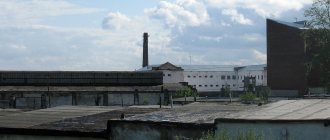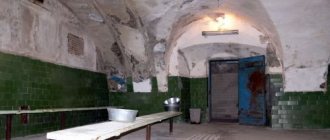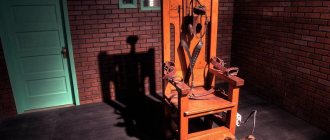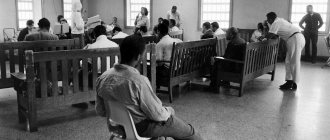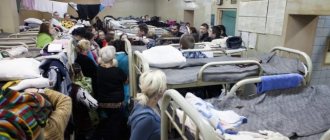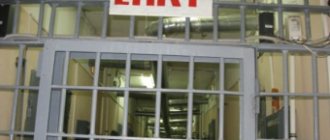Despite statements about the principles of humanity as the basis for the work of the law enforcement system, the problem of violence against suspects, detainees and convicts remains relevant.
Among the methods of influencing prisoners, the press hut is used. This is a cell in which prisoners are kept, following the instructions of the prison administration. A convicted person or suspect (if he is still in a pre-trial detention center) is placed in such a cell in order to force him to comply with the demands of the investigator or FSIN officers.
Methods of influence in the press hut
The reasons for conflicts between a prisoner and law enforcement officials can be completely different. At the investigation stage, the investigator often does not have sufficient objective evidence of the suspect’s guilt. In order to bring the case to trial, he needs the detainee to confess to having committed a crime. When the person himself does not agree to write a statement of sincere confession, despite the promise to commute the sentence, they begin to put pressure on him to force him to admit his guilt.
The pressure can be psychological. In particular, a prisoner in a pre-trial detention center is threatened with being transferred to a press hut, where he will be beaten and sometimes raped. Another common threat is an increase in the sentence for refusal to cooperate with the investigation.
If they fail to intimidate the prisoner, investigators turn to physical violence. By placing a prisoner in a special cell, which is called a press hut, the pre-trial detention center officers themselves can participate in beating the disobedient prisoner, or they will send other prisoners to him, who follow the instructions of the police in exchange for certain concessions while serving his sentence.
The purpose of sending a person to a press hut is to break him mentally and physically. Therefore, all kinds of bullying and threats are used. They are trying to make a person afraid, so that later they can make him completely controllable. The degree of suppression can be as severe as possible, up to and including the use of sexual violence.
Closed territory: secrets of the oldest pre-trial detention center on Seifullina in Almaty November 28, 2022, 16:30
Almaty institution LA-155/1, popularly known as the “Seifullin Pre-trial Detention Center”, is one of the oldest closed facilities of the penal correction system in Kazakhstan. In the middle of the 19th century, during the time of tsarist rule, this place was a transit point for Fort Verny. Essentially the same pre-trial detention center.
Continuation
1. How the famous cultural sites of Almaty were designed
This year it was recognized that the buildings of the detention center, where arrestees and persons under investigation were kept for many years, do not meet modern requirements. The oldest pre-trial detention center in Almaty was recently closed, and all those arrested and under investigation were transferred to another institution on the outskirts of the city. The correspondent managed to visit the building of the pre-trial detention center on Seifullin Avenue, where no one would want to go in ordinary life.
According to archival data, the transit and transit point of Fort Verny, on the site of which the LA-155/1 detention center is now located, was formed at the end of the 19th century.
Inner courtyard of the isolation ward. There is barbed wire around the perimeter. Photo Tengrinews.kz
Over more than a century of history, the now former pre-trial detention center had many different arrestees and persons under investigation. The chief expert of the Central State Archives, Oleg Belonosov, discovered a letter to the Governor-General of the Turkestan Territory, Konstantin von Kaufman. The letter says that the Polish revolutionary Bronislaw Schwarze was transported to Fort Verny from the Shlisselburg fortress in 1870.
Photo of the Central State Archives of Almaty
When arrested in Warsaw, he offered armed resistance and was sentenced to death, which was later replaced by lifelong hard labor. Schwarze remained in prison in Verny until July 1874, after which he was sent to further serve his sentence in Tomsk.
According to the documents, Schwarze was not allowed to see his family, but he was kept in quite acceptable conditions. Every day the convict was allocated 50 kopecks for food and other needs, and piano lessons were allowed.
“I would like to note that at that time 50 kopecks was a serious amount. Judge for yourself - for 10 kopecks you could buy half a kilo of meat. Consequently, in addition to meat, he still had 40 kopecks left for other needs,” says archive employee Oleg Belonosov.
It is known that Tokash Bokin, a participant in the struggle for the establishment of Soviet power in Semirechye and Verny, was once held in the royal prison. It was from here that he was taken to an unknown direction.
“According to the documents of the Central Archives of the Republic of Kazakhstan, there is a certificate prepared by the prison commissioner Shestakov that on September 19, 1918, Tokash Bokin was “removed from prison” by the head of the partisan detachment Kikhtenko. After this, no one saw Bokin. His death has not been documented. The man just disappeared…” said Oleg Belonosov.
Tokash Bokin. Photo wikipedia.org
Under the tsarist regime, the prison was a one-story wooden building. Adjoining it were a church and a small cemetery, which was located slightly to the west and south of the “prison fortress.” There was also a house in which the clergyman lived. Nowadays the building of the Zhetysu District Department of Internal Affairs stands there.
The acting head of institution LA-155/1, Lieutenant Colonel of Justice Abdrakhman Abdildin says: there are no old photos of the detention center left. The documents were kept by a local archivist, but his house burned down, and along with it the historical documents.
After the revolution, in 1922, prison No. 1 of the NKVD of the Kazakh SSR was established on the basis of a former transit point. From 1954 to 1990, the pre-trial detention center was part of the Ministry of Internal Affairs of the Kazakh SSR; later, in 1992, it became part of the Ministry of Internal Affairs of the Republic of Kazakhstan. The detention center was named “Institution LA-155/1 of the Internal Affairs Directorate of the Almaty Region.” From January 1996 to June 1997, the institution was subordinate to the State Inspectorate of the Almaty Region.
The Ministry of Internal Affairs of the Republic of Kazakhstan listed the pre-trial detention center until 2004, later the detention center was transferred to the Ministry of Justice, and in 2012 it was returned to the Ministry of Internal Affairs.
Insulator transitions. Photo Tengrinews.kz
When you approach the pre-trial detention center, the first thing that catches your eye is a beauty salon next to the large blue gate. There, behind the gates, there is a completely different life and its own routine.
Next is a narrow courtyard and the entrance to the territory of the detention center itself. After the checkpoint, where phones are taken and documents are checked, there is a so-called “gateway”. The room is painted blue and somewhat resembles a rural gym and service station at the same time. Perhaps high ceilings and a pit for checking the undersides of cars.
“Vehicles with a special contingent enter through a separate gate, and searches and checks are carried out here. Previously, the guards went down into the pit and checked everything from below, the old fashioned way, now there are special devices - mirrors, but we have already sent them to the new institution,” explains the acting head of the LA-155/1 institution, Abdrakhman Abdildin.
After the “gateway” there is a narrow corridor where there is another “duty room”. Next to it is a room where the arrested are examined and where they wait to be assigned to cells.
In the period from 1974 to 1977, a radical reconstruction was carried out on the site of the pre-trial detention center on Seifullin Avenue. There, the old wooden buildings were demolished and three four-story buildings were built. The fourth was built a little earlier.
In addition, underground communications and underground passages were built at the same time.
Labyrinths with a length of more than 1,500 meters were designed for the movement and escort of detainees. From here those arrested were taken to trials and investigations, for sanitary treatment and to visit the bathhouse. The “inmates” were not taken out into the open.
Nowadays, arrested persons are no longer brought to the detention center. The institution is gradually being liquidated. Only about 50 people work in administration and security.
The total territory of the detention center, including buildings and the courtyard, is 1.9 hectares. The buildings are divided into women's and men's sections.
There are 209 cells in four buildings of the pre-trial detention center. There are 21 single cells, five pre-trial detention centers: disciplinary isolation wards (for violators of the detention regime), there are 4-, 6-, 8-, 10- and 12-bed cells. In addition, there is a bathhouse and a dining room. Occupancy limit is 805 people.
Cells for men are located in a separate building. The doors, and there are two of them in each cell, are closed with bolts and locks.
There are four booths for investigators to work with detainees and arrestees, and 24 booths for lawyers with their clients. The interior is equally official everywhere. Blue and white walls, benches or chairs, table. The arrested leave “messages” on some interior items.
Lieutenant Colonel of Justice Abdrakhman Abdildin has been working here since 1996. According to him, crime peaked in the early 2000s. The cells were overcrowded. There were also attempts to escape from the pre-trial detention center.
“This was around the early 2000s. The arrestee pulled out bricks and began to dismantle the wall. I crushed the bricks, disposed of some of them through the toilet, took some of them out in my pockets and threw them away while walking. A sheet covered the hole. When they found out about this, they neutralized it. Employees of the operational department prevented an escape attempt. There is already a large opening there. If he had succeeded, he would have climbed onto the roof. For the damage caused, the arrested person was put in a punishment cell,” recalls Abdildin.
The atmosphere on the territory of the detention center is not easy—somewhere oppressive and eerie. One of the local horror stories is the appearance of ghosts. They say that doors that are not tightly closed open and close on their own, and moans, screams and crying are heard.
However, the most inexplicable and creepy thing is in the basement. Deep in the labyrinth, a cross is clearly visible on one of the walls. The symbol of the Christian faith is about 30 centimeters high, the crossbar is about 10. It is located at a level of 2 meters from the floor surface. Rumor has it that the cross was repeatedly covered up, painted over and sealed, but over time it appears again and again. When he appeared and why, no one knows.
Detention center No. 1 on Seifullin Avenue was officially closed. However, what will happen to the buildings of the former pre-trial detention center is still unknown.
The Almaty prosecutor's office previously reported that the building of the detention center on Seifullin Avenue was outdated and created inconvenience for residents. In this regard, a decision was made to close the institution.
Who are the “woolies”?
Wanting to submit the will of the prisoner, the prison administration does not always act on its own. Press huts are usually inhabited by controlled prisoners, whom other convicts call "wool" or "wool". This caste in the prison hierarchy is hated by everyone else. Their status is no higher than those who have been lowered.
Have a question for a lawyer? Ask now, call and get a free consultation from leading lawyers in your city. We will answer your questions quickly and try to help with your specific case.
Telephone in Moscow and the Moscow region: +7
Phone in St. Petersburg and Leningrad region: +7
Free hotline throughout Russia: 8 (800) 301-39-20
But unlike the latter, they enjoy the patronage of the prison administration, so they are not in ordinary cells, but live separately. This is how the guards protect them from reprisals from other prisoners. And the “woolen” ones, in turn, do what the FSIN employees tell them. Suppressing new arrivals and prisoners who do not get along with the prison authorities is the main task of the “woolies”.
Despite the protection of FSIN officers, the prisoners serving them often become victims of reprisals. Sometimes other prisoners find them after release.
Combine exercises
It is unlikely that you will be able to pump up a beautiful abs with the help of just bending the body on the floor or on an abdominal bench. Experts advise combining exercises. The optimal workout for getting a six-pack may include, for example, low-range isolated crunches, abdominal crunches, or hanging or incline leg or knee raises. To train the oblique abdominal muscles, crunches from a lying position, which can be done with weights, will also be effective.
How to avoid getting into the press hut?
There is no one hundred percent guarantee that the convicted person will not be sent to this terrible place. If the regime is observed and there are no conflicts with the administration of the colony or investigative authorities, while in a pre-trial detention center, the convict is usually not touched or tried to suppress.
But one can never exclude the human factor, an accidental conflict, especially in prison conditions, and the investigator’s interest in solving the case as quickly as possible.
Before sending the prisoner to the press house, “softer” methods will be used. He will be frightened by the difficulties of prison life and the inability to return to normal life after release. Violence is used if a person is resistant to threats and still does not cooperate with investigative authorities and prison authorities.
The bigger, the better?
One of the most common misconceptions about abdominal training is that the more reps we do in a set, the stronger and more voluminous our abs will be. In fact, the abdominal muscles are no different in terms of training, for example, from the biceps. To increase your biceps, you will begin to do one hundred repetitions per approach; on the contrary, you will reduce the number of sets and repetitions, but increase the load. By increasing the number of repetitions per set, you will develop strength endurance, but this will not make the muscle thicker. It is much more effective to increase the load, do sets with weights and reduce the number of repetitions per set from 8 to 20.
What to do if you get into a press hut?
If it was not possible to avoid falling into such a chamber, you need to try to withstand the pressure. This is not easy and there are no universal recipes here. However, some general advice can be given:
- Be prepared for the worst. The first to break down were those prisoners who believed that this could not happen to them.
- Under no circumstances agree to become one of the “woolen” ones. The consequences of such cooperation with the administration will be long-term and disastrous.
- While in a pre-trial detention center, you must inform your lawyer about the use of violence.
- You need to behave with restraint, but not spineless. Most of all they dislike arrogant provocateurs and those who agree and submissive with everything. The prison does not tolerate this kind of behavior.
Resistance to a superior number of cellmates does not always lead to success. But having survived the pressure in this case, the prisoner retains respect among other prisoners. Once broken, you can easily lose it.
Why do we need abs?
The abdominal muscles belong to the so-called core muscles, a complex of muscles responsible for stabilizing the spine, pelvis and hips. Each of the abdominal muscles is responsible for its own functions. The rectus muscle is for twisting the body in the lumbar region, the external oblique muscle is for rotating the body in the opposite direction, flexing the spinal column, and is involved in the contraction and expansion of the chest. The internal oblique muscle is responsible for the same functions as the external oblique, but is responsible for rotating the body in the other direction. The abdominal muscles, together with the muscles of the lumbar back, allow you to maintain posture, participate in the respiratory process, and in women they play an important role during childbirth.



